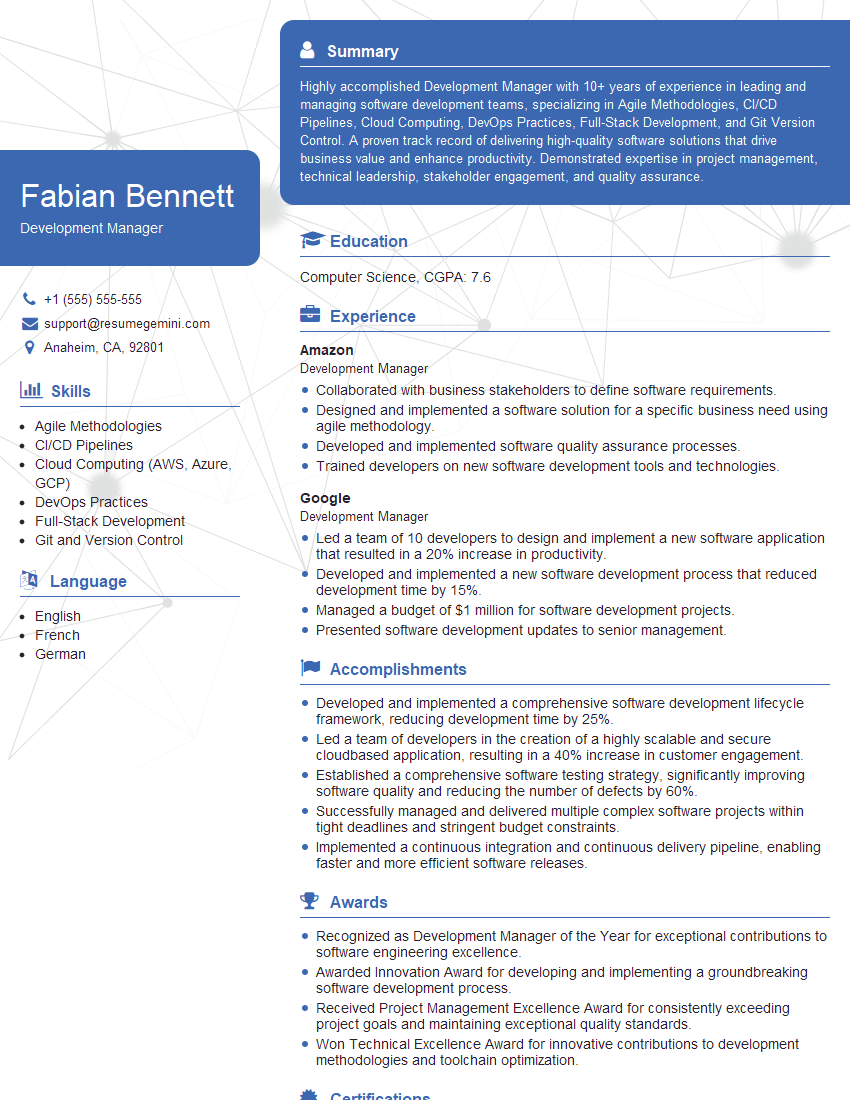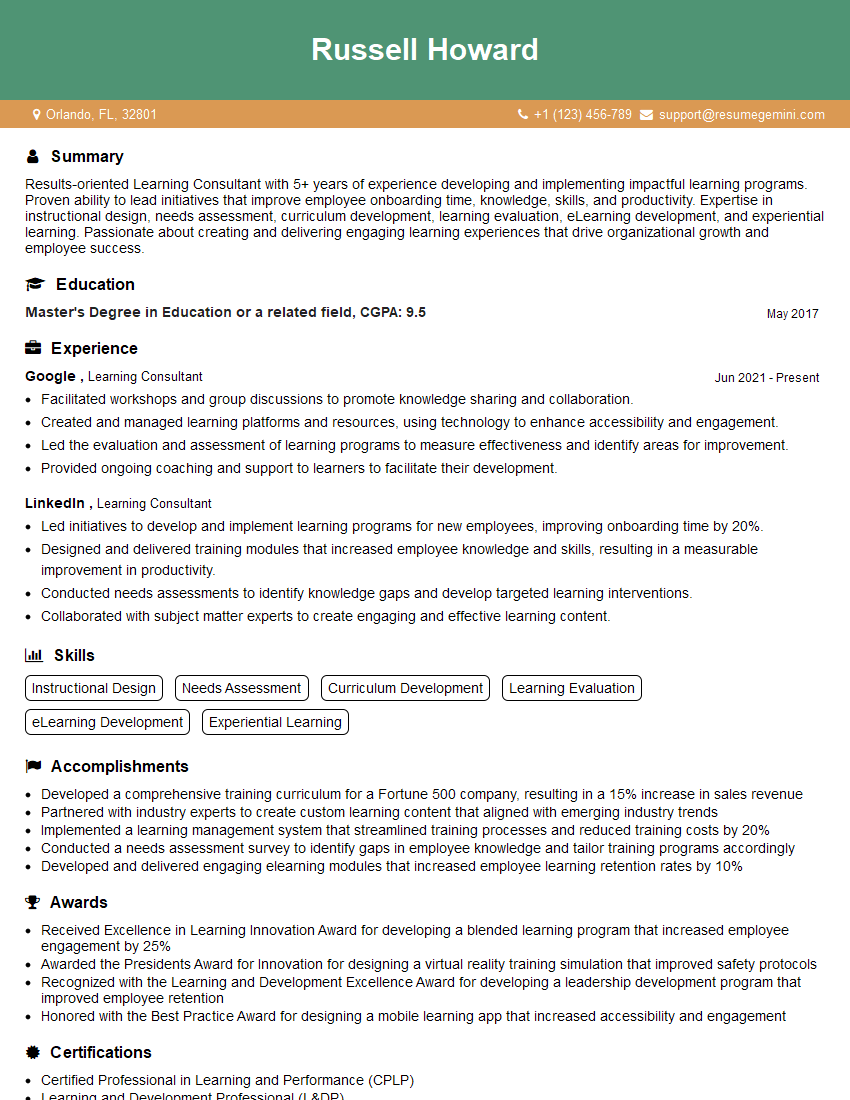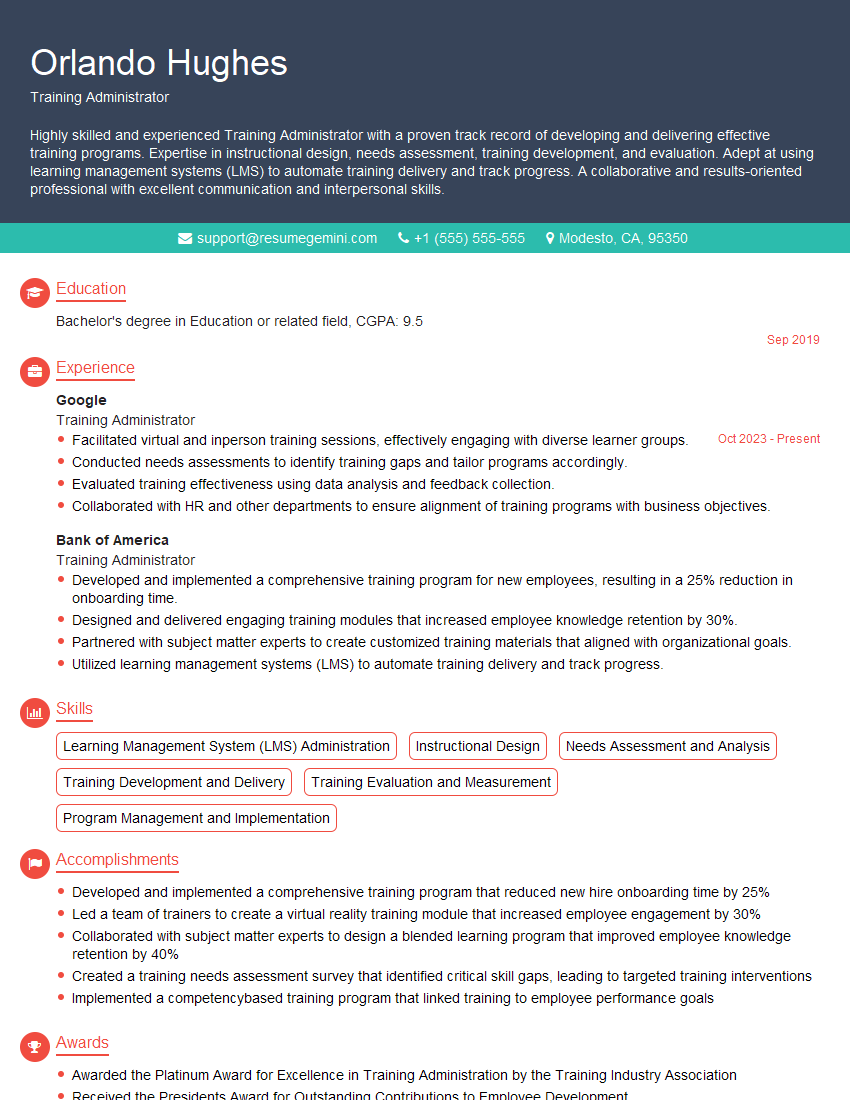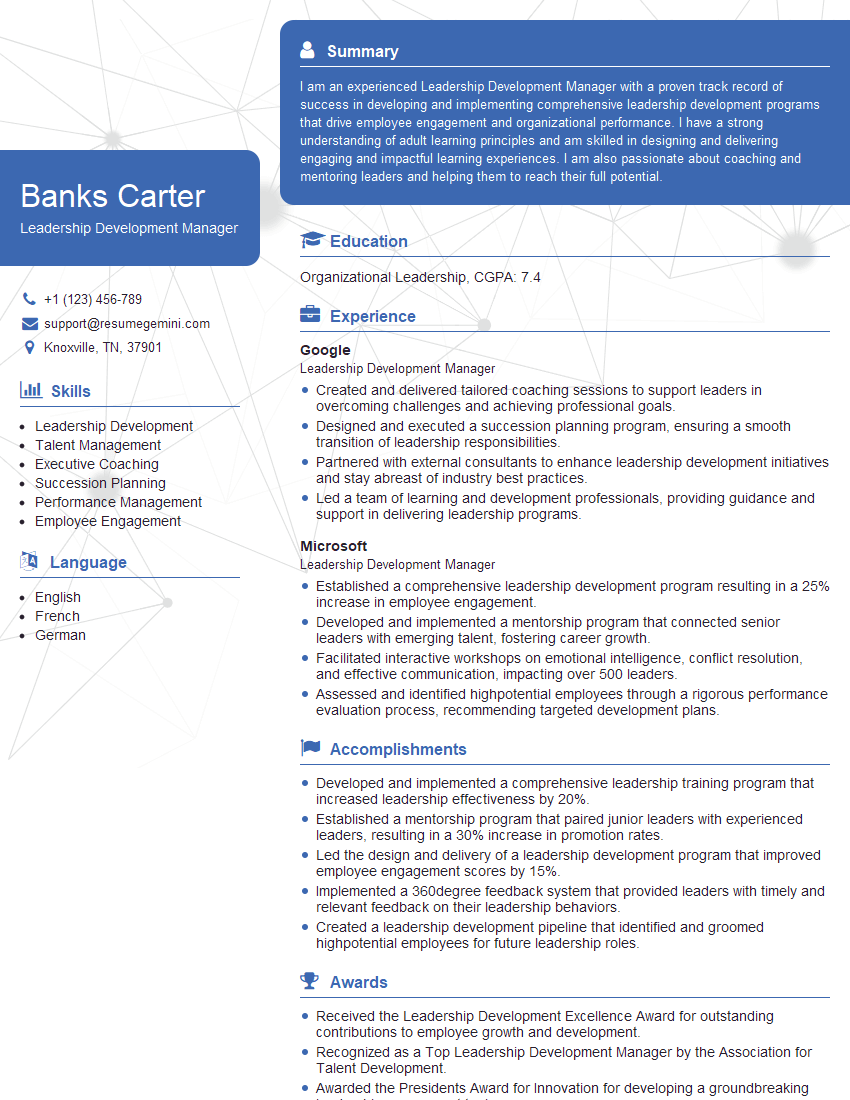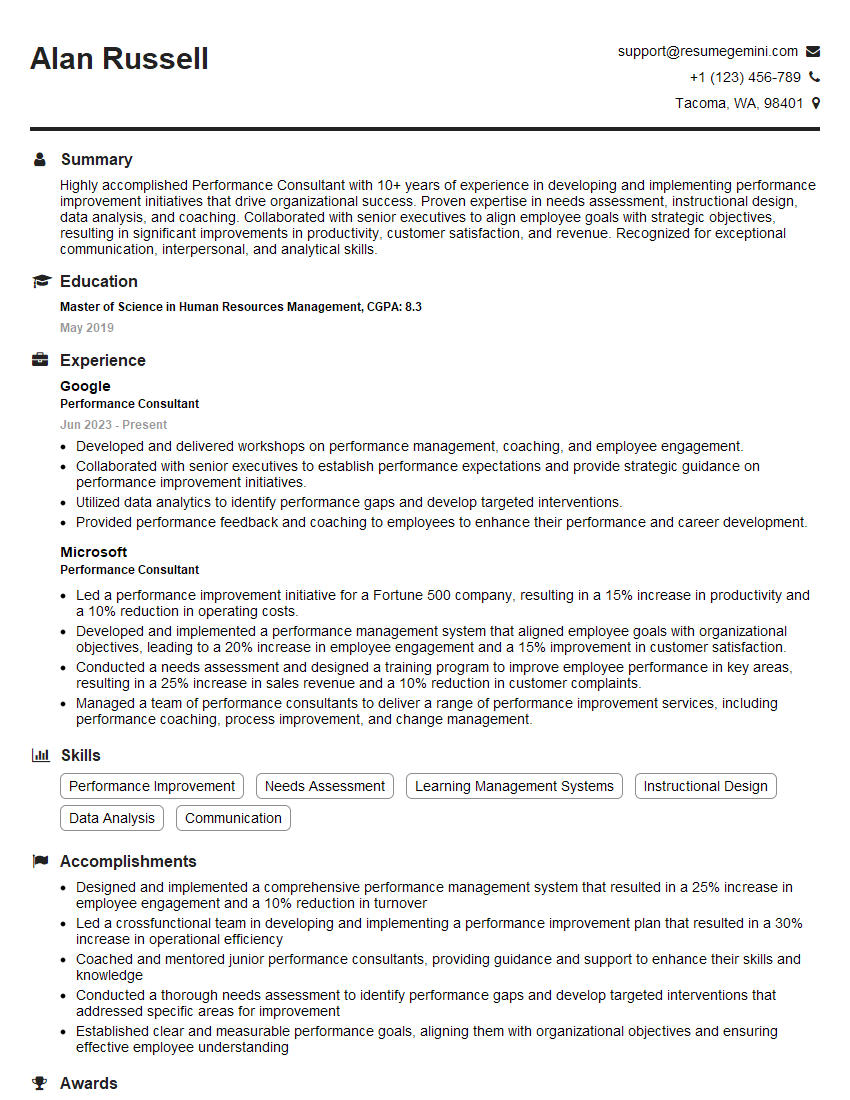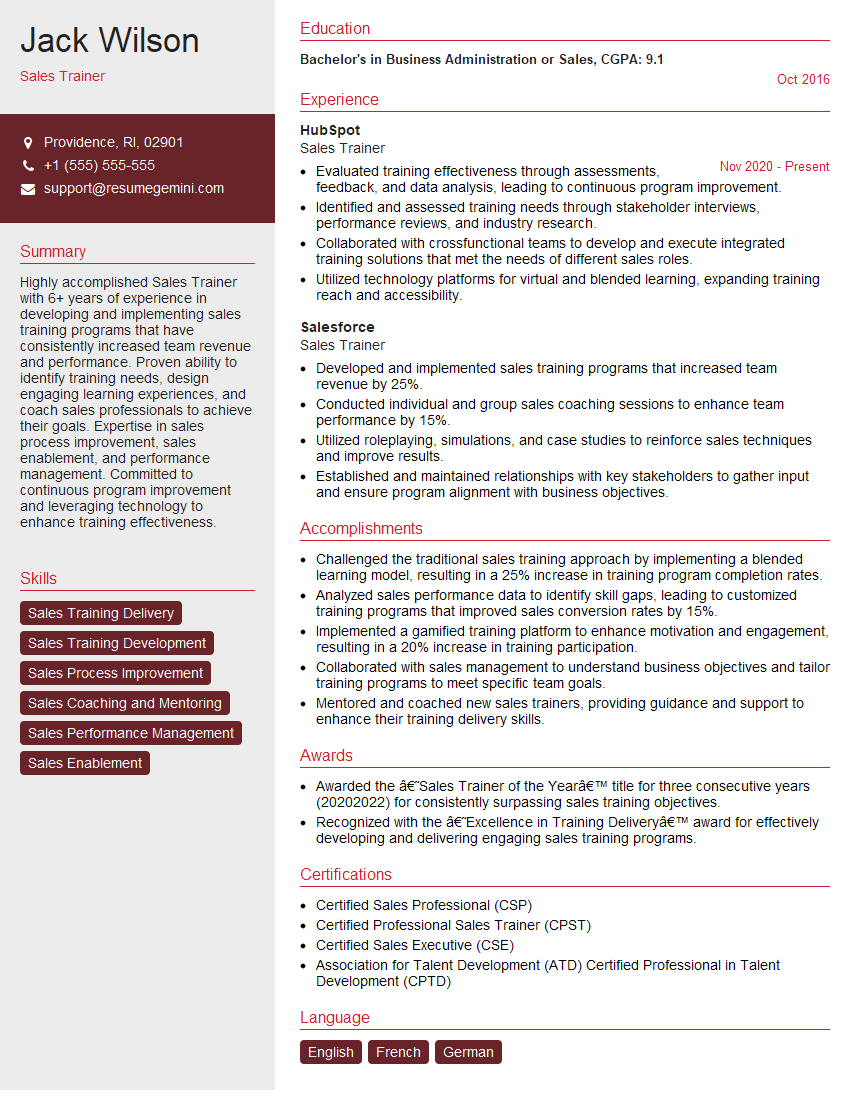The right preparation can turn an interview into an opportunity to showcase your expertise. This guide to Training and mentoring team members interview questions is your ultimate resource, providing key insights and tips to help you ace your responses and stand out as a top candidate.
Questions Asked in Training and mentoring team members Interview
Q 1. Describe your experience designing and delivering training programs.
Designing and delivering training programs is a multifaceted process that begins with a thorough needs analysis and culminates in post-training evaluation. My approach involves several key stages:
- Needs Assessment: I start by identifying the skills gap. This involves interviews, surveys, performance reviews, and observation to pinpoint specific areas needing improvement. For example, if a team struggles with a new software, the training will focus on that software’s functionalities.
- Learning Objectives: Once the needs are identified, I define clear, measurable, achievable, relevant, and time-bound (SMART) learning objectives. This ensures the training directly addresses the identified gap. For instance, an objective might be: “Participants will be able to independently use feature X in software Y by the end of the training.”
- Content Development: I create engaging and relevant training materials, incorporating various methods like presentations, videos, interactive exercises, and case studies. I always strive to use real-world examples applicable to the team’s work.
- Delivery Method Selection: The choice of delivery method – in-person, online, or blended – depends on the training content, audience, and budget. For example, a hands-on software training might necessitate an in-person approach, while a broader compliance training might be more effective online.
- Evaluation and Feedback: Post-training evaluations, including quizzes, surveys, and on-the-job observation, are crucial for measuring effectiveness and making improvements for future iterations. This feedback loop ensures continuous improvement of the training program.
Q 2. How do you assess the effectiveness of your training programs?
Assessing training effectiveness involves a multi-pronged approach to gauge both knowledge acquisition and behavioral changes. I typically employ the following methods:
- Pre- and Post-Training Assessments: These measure the knowledge gained during training. A pre-training assessment establishes a baseline, while a post-training assessment evaluates improvement.
- On-the-Job Observation: This allows me to see how effectively trainees apply learned skills in their actual work environment. This is particularly important for skills-based training.
- Surveys and Feedback Forms: These gather participants’ perspectives on the training’s relevance, engagement, and effectiveness. Open-ended questions provide valuable qualitative data.
- Performance Metrics: Tracking key performance indicators (KPIs) related to the skills taught, such as error rates, productivity, or customer satisfaction, provides objective evidence of training impact. For instance, if training focused on reducing customer support call resolution time, I would track that metric post-training.
- Return on Investment (ROI): Calculating ROI helps demonstrate the value of the training by comparing the cost of training to the improvements in productivity or other measurable benefits.
Q 3. What methods do you use to identify training needs within a team?
Identifying training needs is the cornerstone of effective training program design. My approach involves several methods:
- Performance Reviews and Data Analysis: Reviewing employee performance data, including metrics like error rates, customer feedback, and sales figures, can highlight areas where training may be beneficial.
- Interviews and Focus Groups: Conducting interviews with team members and managers provides valuable insights into their perceived skill gaps and training needs. Focus groups allow for more collaborative discussions.
- Observation and Shadowing: Directly observing employees in their work environment allows for firsthand identification of skill gaps and workflow inefficiencies.
- Surveys and Questionnaires: Distributing surveys to employees can gather data on their perceived training needs and preferences for learning methods.
- Skills Gap Analysis: A formal skills gap analysis compares the current skills of the team to the skills required for optimal performance. This often involves comparing job descriptions to employee skills inventories.
For instance, if performance reviews consistently highlight difficulties in using a particular software, this would indicate a need for training in that software.
Q 4. Explain your approach to creating engaging and effective training materials.
Creating engaging and effective training materials is crucial for successful knowledge transfer. My approach focuses on:
- Varied Learning Methods: I avoid solely relying on lectures or lengthy presentations. Instead, I incorporate interactive elements like games, simulations, group discussions, role-playing, and hands-on exercises. This caters to different learning styles.
- Real-World Examples and Case Studies: I use real-world scenarios and case studies relevant to the team’s work to make the training more relatable and practical.
- Visual Aids and Multimedia: Incorporating visuals like images, videos, and infographics can significantly improve engagement and knowledge retention.
- Clear and Concise Language: I use simple, clear, and concise language, avoiding jargon and technical terms that may confuse participants. I ensure the material is easily understandable.
- Chunking Information: Breaking down complex information into smaller, manageable chunks makes it easier to digest and retain. I also build in regular breaks to avoid cognitive overload.
- Interactive Assessments: Including quizzes and knowledge checks throughout the training helps to reinforce learning and identify any knowledge gaps.
For example, instead of simply lecturing about customer service techniques, I might use a role-playing exercise to simulate customer interactions and provide immediate feedback.
Q 5. How do you handle resistance to training from team members?
Resistance to training can stem from various factors, including fear of change, lack of time, or perceived irrelevance. My approach to addressing resistance is proactive and empathetic:
- Understanding the Resistance: I start by understanding the reasons behind the resistance. This involves open communication and active listening.
- Demonstrating Value: I highlight the benefits of the training, connecting it to individual career goals, team performance, and organizational success.
- Addressing Concerns: I directly address any concerns or anxieties participants may have about the training. This could involve adjusting the training schedule, providing additional support, or offering personalized learning plans.
- Making it Relevant: I tailor the training to the participants’ specific roles and responsibilities, ensuring the content is directly applicable to their work.
- Creating a Supportive Learning Environment: I foster a positive and encouraging learning environment where participants feel comfortable asking questions and sharing concerns.
- Positive Reinforcement and Recognition: I acknowledge and reward participants for their effort and participation, creating a culture of learning and appreciation.
For example, if a team member expresses concern about time constraints, I might offer flexible learning options, such as online modules or self-paced learning.
Q 6. What are your preferred methods for delivering training (e.g., online, in-person, blended learning)?
My preferred method of training delivery is a blended learning approach, combining the strengths of various methods. The best approach depends on the specific training needs and the audience:
- In-Person Training: This is beneficial for hands-on training, team-building activities, and fostering interaction. It is ideal for complex skills requiring immediate feedback.
- Online Training: This is cost-effective, scalable, and flexible. It’s well-suited for large groups or geographically dispersed teams and allows for self-paced learning. Examples include eLearning modules and virtual workshops.
- Blended Learning: This combines the best of both worlds. For instance, an introductory module might be delivered online, followed by an in-person workshop for hands-on practice and collaborative learning.
I always consider factors such as budget, time constraints, learner preferences, and the complexity of the subject matter when selecting a delivery method. For example, a technical skill training might benefit from a blended approach, with online modules to cover theory and in-person sessions for practical application.
Q 7. How do you adapt your training style to different learning styles?
Adapting my training style to different learning styles is paramount for ensuring everyone benefits. I utilize a variety of techniques to accommodate various learning preferences:
- Visual Learners: I use visual aids like diagrams, charts, videos, and presentations. I ensure clear visuals and minimize text-heavy content.
- Auditory Learners: I incorporate discussions, lectures, audio recordings, and group activities to engage auditory learners.
- Kinesthetic Learners: I include hands-on activities, simulations, role-playing, and practical exercises to cater to kinesthetic learners’ preference for active learning.
- Read/Write Learners: I provide written materials, handouts, summaries, and opportunities for note-taking to support read/write learners.
- Multimodal Approach: I strive for a multimodal approach, incorporating various methods within each training session to cater to the diverse learning styles within the group.
I frequently employ a variety of learning activities within a single training session, ensuring that all learning styles are addressed. For example, I might begin with a lecture, followed by a hands-on activity, a group discussion, and finally, a written exercise.
Q 8. Describe your experience using learning management systems (LMS).
My experience with Learning Management Systems (LMS) is extensive. I’ve used various platforms, from Moodle and Canvas to more specialized systems tailored to specific industries. I’m proficient in all aspects, from uploading and managing training materials and tracking learner progress, to customizing learning pathways and generating reports. For instance, in my previous role, I used Moodle to develop a comprehensive onboarding program for new hires, including interactive modules, quizzes, and video tutorials. This resulted in a significant improvement in new hire productivity and faster integration into the team. I also have experience leveraging LMS data to identify training gaps and personalize learning experiences, ensuring learners receive targeted support and resources. Another project involved using an LMS to track compliance training, ensuring all employees were up-to-date with relevant regulations. This involved automating reminders, generating certificates of completion, and reporting compliance status to management.
Q 9. How do you measure the ROI of a training program?
Measuring the ROI of a training program requires a multifaceted approach. It’s not just about the immediate post-training performance boost but also the long-term impact on the organization. I typically use a combination of methods, including:
- Pre- and Post-Training Assessments: Measuring skill improvement through tests or performance evaluations before and after the training to quantify the learning achieved.
- On-the-Job Performance Metrics: Tracking key performance indicators (KPIs) like productivity, sales figures, error rates, or customer satisfaction scores to assess the program’s impact on actual work performance. For example, if a sales training program results in a 10% increase in average sales per salesperson, that’s a quantifiable ROI.
- Return on Investment (ROI) Calculation: This involves comparing the cost of the training program (development, delivery, and participant time) to the financial benefits generated by improved performance. A simple formula might be:
(Return - Cost) / Cost. - Employee Surveys and Feedback: Gathering qualitative data from participants to gauge their satisfaction, perceived value, and application of newly acquired skills on the job. This helps provide context to the quantitative data.
- Cost-Benefit Analysis: Considering both tangible (increased revenue, reduced errors) and intangible benefits (improved morale, increased employee retention) to get a complete picture of the program’s value.
It’s important to set clear, measurable goals before the training to effectively evaluate its success and demonstrate ROI.
Q 10. How do you create a positive and supportive learning environment?
Creating a positive and supportive learning environment is crucial for effective training. I focus on several key aspects:
- Establishing Trust and Respect: Creating a safe space where learners feel comfortable asking questions, sharing opinions, and making mistakes without fear of judgment. This involves active listening and creating opportunities for open communication.
- Providing Clear Expectations: Communicating learning objectives, assessment criteria, and the overall training schedule clearly from the outset. Learners need to know what is expected of them and how their progress will be measured.
- Encouraging Collaboration: Designing activities that promote peer-to-peer learning, such as group projects, discussions, and peer feedback. This helps build camaraderie and reinforces learning.
- Offering Varied Learning Methods: Employing a variety of techniques, including lectures, hands-on activities, simulations, case studies, and games, to cater to different learning styles and maintain engagement.
- Providing Regular Feedback: Offering constructive criticism and positive reinforcement throughout the learning process to help learners stay motivated and improve their performance.
- Celebrating Successes: Acknowledging and celebrating learners’ achievements, big or small, fosters a sense of accomplishment and encourages further learning.
Think of it like gardening – you need the right environment (trust, clear expectations), the right tools (varied methods), and consistent nurturing (feedback) to help the seeds of knowledge grow.
Q 11. What strategies do you use to foster collaboration and knowledge sharing within a team?
Fostering collaboration and knowledge sharing is essential for team growth. I employ several strategies:
- Knowledge-Sharing Platforms: Implementing tools like wikis, shared document repositories, or internal social networks to facilitate the easy exchange of information and best practices.
- Cross-Training Initiatives: Encouraging team members to learn from each other by rotating roles or participating in shadowing programs. This helps build a well-rounded team and strengthens knowledge across departments.
- Regular Team Meetings: Holding consistent meetings dedicated to knowledge sharing, where team members can present their work, share lessons learned, or discuss challenges and solutions.
- Mentorship Programs: Pairing experienced team members with newer colleagues to facilitate knowledge transfer and provide guidance.
- Communities of Practice (CoPs): Forming groups of individuals with shared interests or expertise to discuss common challenges, share knowledge, and collaborate on projects. This could be focused on a specific technology or a particular area of expertise.
- Gamification: Introducing elements of friendly competition or rewards to encourage knowledge sharing and engagement, for instance, awarding points for helpful contributions on a shared platform.
The key is to create a culture where sharing is not only encouraged but also valued and rewarded.
Q 12. Describe your experience mentoring team members.
My mentoring experience spans several years and various roles. I’ve mentored junior team members, recent graduates, and colleagues transitioning to new roles. I approach mentoring with a focus on individual needs and goals. For example, I recently mentored a junior data analyst who was struggling to visualize complex data. We worked together to identify his learning gaps (specifically in using data visualization tools) and created a personalized development plan. This involved suggesting specific online courses, providing feedback on his work, and guiding him through challenging projects. This involved regular check-ins, providing tailored resources, and celebrating milestones achieved. The result was a significant improvement in his data visualization skills and a boost in confidence.
Q 13. How do you provide constructive feedback to mentees?
Providing constructive feedback is a crucial aspect of mentoring. I follow the ‘sandwich’ method: starting with positive feedback, followed by constructive criticism, and ending with more positive reinforcement. I focus on:
- Specificity: Instead of saying ‘your presentation was poor’, I’d say ‘Your presentation’s introduction could benefit from a stronger hook to better engage the audience; however, your data analysis was very thorough and well-presented.’
- Actionable Advice: I offer concrete suggestions for improvement, rather than just pointing out flaws. For example, instead of simply saying “your code is inefficient,” I would suggest specific code optimization techniques or point to relevant documentation.
- Focus on Behavior, Not Personality: I focus on observable behaviors and their impact, avoiding personal attacks. Instead of saying ‘you’re lazy’, I would focus on a specific instance, such as ‘The deadline was missed on this project, and that impacted the team’s workflow. Let’s discuss time management strategies.’
- Two-Way Conversation: I encourage open dialogue, asking for the mentee’s perspective and addressing their concerns. I want to understand their challenges and work collaboratively to find solutions.
The goal is to help the mentee learn and grow, not to make them feel discouraged.
Q 14. How do you identify and address performance gaps in your mentees?
Identifying and addressing performance gaps requires careful observation and open communication. I use a combination of approaches:
- Performance Reviews and 360-Degree Feedback: Regular performance reviews help identify areas where the mentee needs improvement. 360-degree feedback provides a holistic view from various perspectives.
- Observation and Informal Check-ins: Regularly observing the mentee’s work and engaging in informal check-ins allow for timely identification of emerging issues. This allows for early intervention and prevents small problems from becoming bigger issues.
- Skill Assessments and Gap Analysis: Using formal assessments to identify specific skill deficiencies and tailoring development plans accordingly. A gap analysis, comparing required skills to current skill levels, helps determine areas needing focus.
- Personalized Development Plans: Collaboratively creating plans that address specific performance gaps. This might involve additional training, mentorship, job shadowing, or assignment to projects that help develop the needed skills.
- Regular Follow-up and Monitoring: Continuously monitoring progress and providing ongoing support to ensure the mentee is on track and achieving their development goals. This includes regular check-ins and progress reviews.
Remember, addressing performance gaps is a collaborative process. It’s about working with the mentee to identify solutions and support their growth.
Q 15. How do you help mentees set and achieve their professional goals?
Helping mentees set and achieve professional goals is a collaborative process built on trust and mutual understanding. It starts with a thorough needs assessment, understanding their aspirations, skills, and career trajectory. I utilize a structured approach, often employing the SMART goal framework (Specific, Measurable, Achievable, Relevant, Time-bound). We work together to define concrete, achievable steps, breaking down larger goals into manageable milestones. For example, if a mentee wants to become a project manager, we’ll identify necessary certifications, skills to develop (like leadership or communication), and create a timeline for each achievement. Regular check-ins, feedback sessions, and performance reviews are crucial for tracking progress, addressing challenges, and making necessary adjustments. We’ll also explore potential roadblocks and develop contingency plans. Finally, I emphasize celebrating successes along the way to boost morale and maintain motivation.
Career Expert Tips:
- Ace those interviews! Prepare effectively by reviewing the Top 50 Most Common Interview Questions on ResumeGemini.
- Navigate your job search with confidence! Explore a wide range of Career Tips on ResumeGemini. Learn about common challenges and recommendations to overcome them.
- Craft the perfect resume! Master the Art of Resume Writing with ResumeGemini’s guide. Showcase your unique qualifications and achievements effectively.
- Don’t miss out on holiday savings! Build your dream resume with ResumeGemini’s ATS optimized templates.
Q 16. How do you build rapport and trust with your mentees?
Building rapport and trust with mentees is paramount for effective mentoring. It’s built on active listening, empathy, and genuine interest in their well-being and career development. I start by creating a safe and open environment where they feel comfortable sharing their thoughts and concerns without judgment. This involves demonstrating respect, valuing their perspectives, and maintaining confidentiality. I share my own experiences, both successes and failures, to build trust and show vulnerability. Regular one-on-one meetings are crucial, and I make a point to understand their personal circumstances and working style. For instance, I might informally ask about their family, hobbies, or challenges outside of work to establish a stronger connection. Consistent follow-up on commitments and providing constructive feedback in a supportive manner reinforce trust and establish me as a reliable resource.
Q 17. How do you handle situations where a mentee is struggling?
When a mentee is struggling, my approach focuses on understanding the root cause of the problem. This involves actively listening to their concerns, identifying any obstacles hindering their progress, and collaboratively brainstorming solutions. I avoid quick fixes and instead encourage self-reflection and problem-solving skills. For example, if a mentee is struggling with a specific technical skill, I might suggest additional training resources, pair programming sessions with more experienced colleagues, or breaking down the task into smaller, more manageable components. If the struggle is related to emotional challenges or workplace dynamics, I might refer them to HR or other support services. It’s crucial to provide tailored support, being patient, supportive, and offering encouragement throughout the process. Regular check-ins and offering different approaches are vital. Sometimes, reframing the challenge or celebrating small victories can significantly boost morale and confidence.
Q 18. What is your approach to providing ongoing support to mentees?
Ongoing support extends beyond scheduled meetings and involves creating a continuous feedback loop. I encourage regular communication, providing both formal and informal channels for feedback. This could include email updates, quick check-in calls, or impromptu discussions. I also connect mentees with relevant resources and networks within the organization, facilitating knowledge sharing and collaboration. I utilize different communication methods based on individual preferences. For instance, some mentees might prefer email for formal updates, while others prefer informal chats. Mentoring is an evolving relationship; the support provided adapts to the mentee’s needs as they progress. It’s essential to consistently reinforce progress and address emerging challenges in a proactive manner.
Q 19. Describe your experience with performance management systems.
My experience with performance management systems involves utilizing them to support, track, and evaluate individual progress toward goals. I’m adept at integrating mentoring goals with formal performance reviews. This ensures alignment between the mentee’s personal development objectives and the organization’s expectations. I often use performance management systems to document progress, identify areas for improvement, and create action plans. For example, using a system that allows for setting key performance indicators (KPIs) linked to professional development goals allows for more objective tracking and provides data-driven feedback. I believe that performance management systems should be used as a constructive tool for growth, not just evaluation.
Q 20. How do you use technology to enhance training and mentoring effectiveness?
Technology significantly enhances training and mentoring effectiveness. I utilize various tools to streamline communication, deliver training content, and track progress. For instance, video conferencing platforms (like Zoom or Microsoft Teams) facilitate remote mentoring sessions, allowing geographically dispersed mentees access to support. Learning management systems (LMS) are used to deliver structured training materials, track completion rates, and facilitate assessments. Collaboration tools (like Slack or Microsoft Teams) foster communication and knowledge sharing within the mentee’s network. I also use project management software (such as Asana or Trello) to track the progress of goals and milestones. These tools empower both the mentor and mentee with more efficient methods for learning, collaboration, and communication.
Q 21. How do you stay current with the latest trends in training and development?
Staying current with the latest trends in training and development involves a multi-faceted approach. I regularly attend industry conferences, webinars, and workshops to learn about innovative methodologies and best practices. I actively participate in professional organizations and networks, engaging in discussions and sharing knowledge with other professionals. I subscribe to industry publications and follow thought leaders on social media to stay abreast of emerging trends. I also dedicate time to self-directed learning, exploring online courses and resources on topics like adult learning principles, instructional design, and new technologies. Continuous learning is essential to remain effective and adapt to the ever-evolving landscape of training and development.
Q 22. Describe a time you had to adapt a training program due to unexpected circumstances.
Adaptability is crucial in training. Once, I was delivering a technical training program on a new software platform. The software vendor unexpectedly released a major update mid-training, rendering a significant portion of my prepared materials obsolete.
Instead of panicking, I immediately assessed the changes. The core concepts remained the same, but the interface had changed. I quickly decided to leverage the situation as a learning opportunity. I presented the update as a real-world example of how things change rapidly in the tech industry and explained how to navigate such situations. I focused on the underlying principles, adjusting my examples and hands-on exercises to reflect the new interface. I also provided supplemental materials with the updated information, available online. This approach not only prevented a complete disruption but also reinforced the trainees’ problem-solving and adaptation skills.
This experience highlighted the importance of having a flexible training plan, access to updated resources, and the ability to think on your feet. My trainees appreciated my quick thinking and proactive response, demonstrating that adapting to unexpected events can actually enhance the learning experience.
Q 23. What are your strengths and weaknesses as a trainer and mentor?
My strengths as a trainer and mentor lie in my ability to build strong rapport with individuals, tailor my approach to different learning styles, and provide constructive feedback that motivates improvement. I excel at creating engaging and interactive learning environments, often incorporating real-world case studies and simulations.
One area I am actively working on is my delegation skills. While I’m highly effective at training and mentoring, I sometimes find it difficult to relinquish control of tasks, preferring to ensure things are completed to my standards. I’m addressing this by consciously delegating more tasks and providing clear expectations and support to mentees, allowing them to develop their own skills and confidence.
Q 24. What is your experience with different training methodologies (e.g., ADDIE, Agile)?
I’m proficient in several training methodologies. The ADDIE model (Analysis, Design, Development, Implementation, Evaluation) provides a structured approach, perfect for well-defined training needs. I utilize this for creating comprehensive, structured courses, especially for compliance or technical skills training. For example, when developing a course on data security protocols, the ADDIE framework ensures that all aspects are addressed from initial needs assessment to post-training evaluation.
Conversely, Agile methodologies are more iterative and flexible, better suited for projects where the requirements may evolve. I’ve successfully implemented this approach when training teams on new software development processes. We started with a core set of skills, and then iteratively added modules and refined the training based on team feedback and evolving needs, allowing for faster adaptation to dynamic project requirements.
Q 25. How do you ensure inclusivity and accessibility in your training programs?
Inclusivity and accessibility are paramount in my training approach. I ensure that my programs cater to diverse learning styles and needs by employing various strategies. This includes:
- Diverse learning materials: Using a mix of visual aids, audio, and interactive activities.
- Flexible delivery methods: Offering both in-person and online training to accommodate different preferences and accessibility needs.
- Accessibility features: Incorporating features such as captions, transcripts, and screen reader compatibility in online materials.
- Culturally sensitive content: Ensuring the content and language used are inclusive and respectful of diverse backgrounds.
- Open communication: Encouraging trainees to express their needs and preferences to ensure the training meets their individual requirements.
For example, when delivering a workshop on effective communication, I provided visual aids for learners with auditory processing challenges and ensured the online materials were accessible to those with visual impairments. I also encouraged active participation, offering varied ways for people to share their thoughts and perspectives.
Q 26. How do you maintain confidentiality when working with mentees?
Maintaining confidentiality is essential in a mentoring relationship. I clearly establish expectations regarding confidentiality from the outset, emphasizing that anything discussed during our sessions remains private unless legally required to be disclosed.
I avoid discussing mentees’ situations with others, even casually. If I need to discuss challenges or progress with a supervisor, I do so in a way that protects the mentee’s identity and sensitive information. I also ensure that any documents or records related to mentees are stored securely and in compliance with relevant data protection regulations.
Trust is fundamental to a successful mentoring relationship, and upholding confidentiality is vital to building that trust.
Q 27. Describe a time you had to deal with a challenging mentee.
I once mentored a team member who was consistently struggling with meeting deadlines and seemed demotivated. After initially providing feedback and support, I realized a deeper issue was at play. We scheduled a one-on-one meeting outside the usual mentoring session to understand the situation more thoroughly, creating a safe space for open communication.
Through active listening and empathetic questioning, I discovered that he was dealing with personal challenges that were affecting his work. I offered my support without judgment and connected him with relevant employee assistance programs. We adjusted his workload and created a more manageable schedule. We focused on setting smaller, achievable goals and celebrating his successes, slowly rebuilding his confidence and motivation. This situation taught me the importance of viewing mentees as whole individuals, and to be responsive to their needs beyond just professional development.
Q 28. What are your salary expectations for this role?
My salary expectations for this role are in the range of [Insert Salary Range] annually. This is based on my experience, skills, and the responsibilities outlined in the job description. I am flexible and open to discussing this further based on the specific details of the role and the overall compensation package.
Key Topics to Learn for Training & Mentoring Team Members Interview
- Needs Assessment & Learning Objectives: Defining the training needs of team members through observation, feedback, and performance reviews. Setting clear, measurable, achievable, relevant, and time-bound (SMART) learning objectives.
- Training Delivery Methods: Understanding and selecting appropriate training methods (e.g., on-the-job training, workshops, online courses, mentoring programs) based on learning styles and content. Practical application includes designing engaging training materials and delivering effective presentations.
- Mentorship Strategies: Developing effective mentoring relationships, providing constructive feedback, and guiding mentees’ professional development. This includes understanding different mentoring styles and adapting approaches based on individual needs.
- Performance Evaluation & Feedback: Developing methods for tracking training effectiveness and providing constructive feedback to both trainees and mentees. This involves using data to inform training adjustments and demonstrating a commitment to continuous improvement.
- Adult Learning Principles: Applying principles of adult learning theory (andragogy) to create engaging and effective training programs. Understanding how adult learners differ from children and adapting your approach accordingly.
- Communication & Interpersonal Skills: Mastering effective communication techniques for building rapport, providing clear instructions, and fostering a supportive learning environment. This includes active listening, empathy, and conflict resolution skills.
- Technology & Training Tools: Familiarity with various learning management systems (LMS) and other technologies used in delivering training. This could include experience with virtual training platforms or e-learning content creation tools.
- Diversity, Equity, and Inclusion in Training: Designing and delivering training that is inclusive and accessible to all learners, regardless of background or ability. Understanding and addressing potential biases in training materials and delivery methods.
Next Steps
Mastering the art of training and mentoring team members is crucial for career advancement, showcasing your leadership potential and ability to foster team growth. To significantly improve your job prospects, create a compelling and ATS-friendly resume that highlights your relevant skills and experiences. ResumeGemini is a trusted resource that can help you build a professional resume tailored to the specific demands of a Training and Mentoring role. Examples of resumes tailored to Training and mentoring team members are available to guide you.
Explore more articles
Users Rating of Our Blogs
Share Your Experience
We value your feedback! Please rate our content and share your thoughts (optional).
What Readers Say About Our Blog
Hello,
We found issues with your domain’s email setup that may be sending your messages to spam or blocking them completely. InboxShield Mini shows you how to fix it in minutes — no tech skills required.
Scan your domain now for details: https://inboxshield-mini.com/
— Adam @ InboxShield Mini
Reply STOP to unsubscribe
Hi, are you owner of interviewgemini.com? What if I told you I could help you find extra time in your schedule, reconnect with leads you didn’t even realize you missed, and bring in more “I want to work with you” conversations, without increasing your ad spend or hiring a full-time employee?
All with a flexible, budget-friendly service that could easily pay for itself. Sounds good?
Would it be nice to jump on a quick 10-minute call so I can show you exactly how we make this work?
Best,
Hapei
Marketing Director
Hey, I know you’re the owner of interviewgemini.com. I’ll be quick.
Fundraising for your business is tough and time-consuming. We make it easier by guaranteeing two private investor meetings each month, for six months. No demos, no pitch events – just direct introductions to active investors matched to your startup.
If youR17;re raising, this could help you build real momentum. Want me to send more info?
Hi, I represent an SEO company that specialises in getting you AI citations and higher rankings on Google. I’d like to offer you a 100% free SEO audit for your website. Would you be interested?
Hi, I represent an SEO company that specialises in getting you AI citations and higher rankings on Google. I’d like to offer you a 100% free SEO audit for your website. Would you be interested?
good
